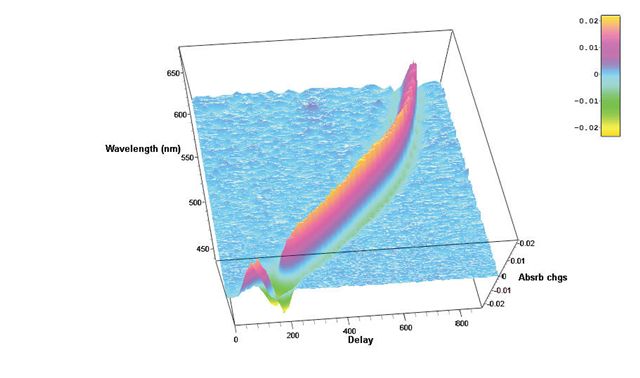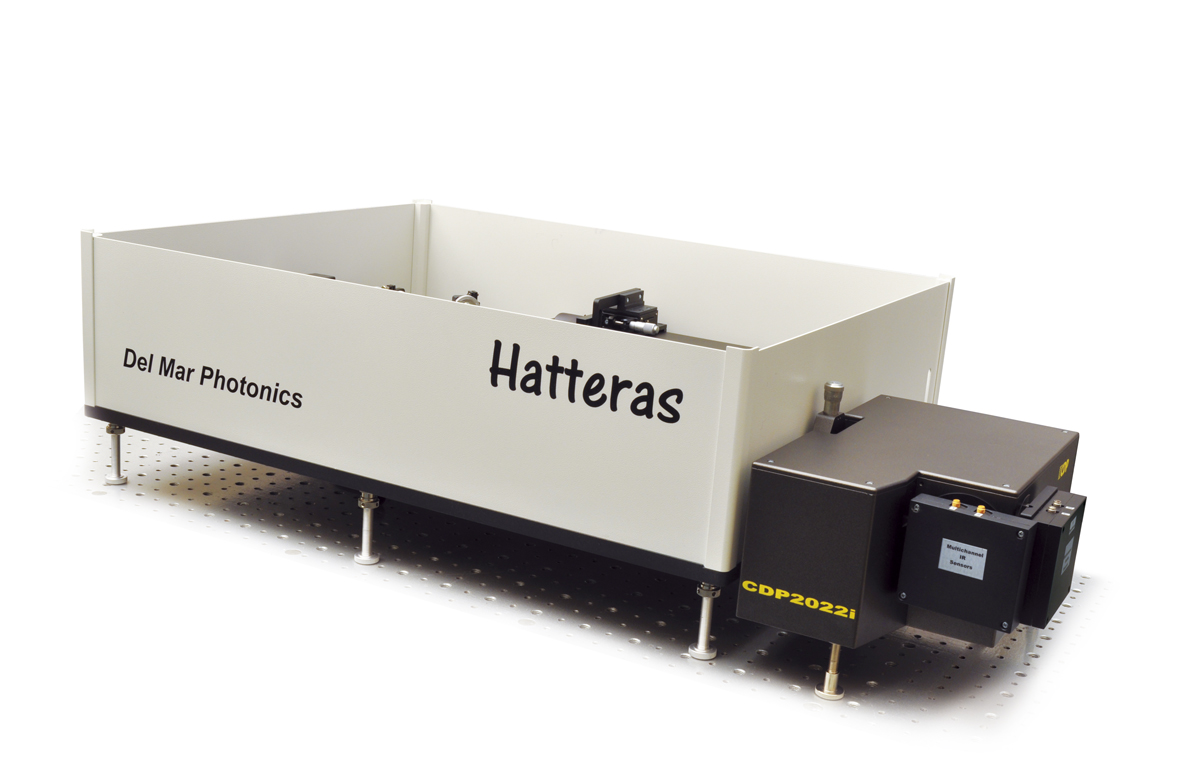Del Mar
Photonics -
Hatteras brochure -
Request a quote -
Custom Femtosecond Transient Absorption Data Acquisition Systems
Main advantages of Hatteras pump-probe (transient absorption) spectrometer:
 |
Femtosecond Transient Absorption Measurements system
Hatteras.
Future nanostructures and biological nanosystems will take
advantage not only of the small dimensions of the objects but of the
specific way of interaction between nano-objects. The interactions
of building blocks within these nanosystems will be studied and optimized on
the
femtosecond time scale - says Sergey Egorov, President and CEO of Del Mar
Photonics, Inc. Thus we put a lot of our efforts and resources into the
development of new Ultrafast
Dynamics Tools such as our Femtosecond Transient Absorption Measurements
system Hatteras. Whether you want to
create a new photovoltaic system that will efficiently convert photon energy
in charge separation, or build a molecular complex that will dump photon energy
into local heat to kill cancer cells, or create a new fluorescent probe for
FRET microscopy, understanding of internal dynamics on femtosecond time scale
is utterly important and requires advanced measurement techniques. |

1. We use pump-probe configuration, where two signals (probe and reference) are
measured by two linear image sensors. This configuration is very important for
precision optical density changes (ΔOD) measurements, because one can get
results independent on probe beam fluctuations. Calculation of probe to
reference ratio is the key principle of the pump - probe method. To our
knowledge, probe beam only without reference one is used by other pump-probe
systems, and device
sensitivity in this case is seriously limited by probe beam stability.

2. Two linear image sensors of Hatteras are placed in the focal plane of high
quality imaging spectrometer with four-grating turret to provide automatic
grating switching. Two standard gratings are installed to cover 330 nm – 1700 nm
spectral range with 206 nm detection range. A central wavelength of the
detection range is computer controlled. Two other gratings are available
optionally on the customer’s choice and request. To our knowledge, simple
spectrometer, configured for one fixed spectral range and equipped with one
sensor, is used by other pump-probe systems. We use spectrometer specially designed for pump-probe
measurements.
3. Hatteras CDP2022C imaging spectrometer has two outputs. Multichannel detector head is
mounted on the first one, and the second one is for optional single channel
detector head, containing two (probe and reference) photodiodes. This single
channel option is important for high quality transient absorption kinetics
measurements at given wavelength. Because of larger photo detector area and
larger detector dynamic range, single channel system usually gives better ΔOD
sensitivity than multichannel one (both systems use probe and reference beams).
Other pump-probe systems do not offer this option.
4. We offer:
• Si multi channel head (200 nm – 1000 nm),
• InGaAs multi channel head (900 nm – 1700 nm),
• Si single channel detector head (320 nm – 1060 nm, 190 nm – 1100 nm on
request)
• InGaAs single channel head (900 nm – 1700 nm, 900 - 2000 nm on request)
• CdHgTe (1 m - 17 m) single channel head
Hatteras is a modular system. If you order visible multi channel head as a basic
one, in future you can order other heads and connect to your control unit. One
multi channel and two single channel heads can be connected to the control unit
simultaneously.
Other pump-probe systems do not offer these possibilities.
5. Hatteras-T kit of optical and mechanical components is flexible to satisfy
user’s requirements. For example, a configuration with two single channel heads
is used for single scan anisotropy kinetic measurements (both kinetics are recorded
simultaneously for parallel and perpendicular polarization). To our knowledge,
other pump-probe spectrometers do not realize many configurations available in
Hatteras.
6. Hatteras configurations give possibilities to direct probe and reference beams
to the entrance slit of the monochromator fiber coupling or directly
(free-space).
First method is simpler. Second method requires more precise adjustments, but
gives better S/N, especially in UV region. To our knowledge, fiber coupling only is
used by other pump-probe systems.
7. Hatteras offer many sample holder options including specially designed
rotation cell. It gives a
possibility of “pseudo single-shot experiment”, when every pulse at 1 kHz hits a
fresh sample. To our knowledge, only single sample holder such as shaking sample cell only is used by
other pump-probe systems. It
is simplest solution and we used that approach 20 years ago…
8. Linear image sensors with 1024 pixels (sensitive at 200 nm – 1000 nm) are
used in the Hatteras. To our knowledge, other
pump-probe systems use sensor with 512 pixels.
9. Extra-deep well photodiode linear image sensors are used in the
Hatteras. These sensors were specially designed for
photometric applications like transient absorption pump-probe experiments where
very small signal changes should be detected. CCD detectors used in other
pump-probe systems are not photometric devices
and give less S/N.
10. 2. 0 ns delay line with 0.78125 min step is used in the Hatteras. 1.6 ns
delay line with 3.5 fs min step is used in other pump-probe systems.
11. Pump pulse energy is measured for every pulse (special photodiode is used
for this purpose). Pump pulse margins or normalization can be applied for
further S/N improvement.
12. CDP2017 frequency conversion option (optical parametric amplifier with
frequency mixing and second harmonic) was specially designed to make pump beam
easy tunable in 480 nm – 800 nm spectral range. Although one can use other
optical parametric amplifiers, CDP 2017 gives cheaper solution and better
matching with Hatteras.
13. Alternatively, TOPAS from Light Conversion (Lithuania) or OPerA Solo from
Coherent is recommended as a computer controlled OPA operated with
Hatteras ExciPro
software.
14. Our data sheet demonstrates well resolved transient absorption peak of
0.0003 OD and corresponding noise is less than 0.0001 RMS. Although other
pump-probe systems claim 0.0002 OD noise, all available data sheets show one and the same
spectrum where scale for the optical changes is not shown.
15. Hatteras ExciPro software makes user friendly data
acquisition, chirp correction and some procedures for instant data analysis. On
the other hand, obtained 3D spectra can be easy exported to various special data
analysis software like Mathematica, Origin, Femtoscan, or Surface Xplorer.
E-mail us to discuss custom software package.

16. Hatteras optical unit together with the spectrometer is more compact than
other pump-probe systems optical unit, although we use probe – reference scheme, rotating sample
cell, Berek’s wave plate assembly and other components which are not used in
other systems.
18. Hatteras has been designed by ultrafast dynamics veterans in 1999 – 2000 for precision
measurements of small photo induced optical density changes (ΔOD) in wide
spectral range. Using our own many years experience in pump-probe experiments,
as well as experience of leading laboratories, all components were specially
designed, selected, and tested to make state-of-the-art system with best
specifications. Hatteras is first femtosecond transient absorption spectrometer
on the market.

Del Mar Photonics
Product Data Sheets
Del Mar Photonics Product brochures -
Femtosecond products data sheets (zip
file, 4.34 Mbytes) - Del Mar Photonics
Send us a request for
standard or custom ultrafast (femtosecond) product
Pulse
strecher/compressor
Avoca SPIDER system
Buccaneer femtosecond
fiber lasers with SHG Second Harmonic Generator
Cannon Ultra-Broadband Light
Source
Cortes Cr:Forsterite
Regenerative Amplifier
Infrared
cross-correlator CCIR-800
Cross-correlator Rincon
Femtosecond Autocorrelator
IRA-3-10
Kirra Faraday Optical Isolators
Mavericks femtosecond
Cr:Forsterite laser
OAFP optical attenuator
Pearls femtosecond fiber laser
(Er-doped fiber, 1530-1565 nm)
Pismo pulse picker
Reef-M femtosecond scanning
autocorrelator for microscopy
Reef-RTD scanning
autocorrelator
Reef-SS single shot
autocorrelator
Femtosecond Second Harmonic Generator
Spectrometer ASP-100M
Spectrometer ASP-150C
Spectrometer ASP-IR
Tamarack and Buccaneer
femtosecond fiber lasers (Er-doped fiber, 1560+/- 10nm)
Teahupoo femtosecond Ti:Sapphire regenerative amplifier
Femtosecond
third harmonic generator
Tourmaline femtosecond fiber
laser (1054 nm)
Tourmaline TETA Yb
femtosecond amplified laser system
Tourmaline Yb-SS
femtosecond solid state laser system
Trestles CW Ti:Sapphire
laser
Trestles femtosecond
Ti:Sapphire laser
Trestles Finesse
femtosecond lasers system integrated with DPSS pump laser
Wedge Ti:Sapphire multipass amplifier



